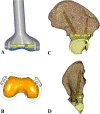Computer-assisted tumor surgery in malignant bone tumors
- PMID: 22948530
- PMCID: PMC3563803
- DOI: 10.1007/s11999-012-2557-3
Computer-assisted tumor surgery in malignant bone tumors
Abstract
Background: Small recent case series using CT-based navigation suggest such approaches may aid in surgical planning and improve accuracy of intended resections, but the accuracy and clinical use have not been confirmed.
Questions/purposes: We therefore evaluated (1) the accuracy; (2) recurrences; and (3) function in patients treated by computer-assisted tumor surgery (CATS).
Methods: From 2006 to 2009, we performed CATS in 20 patients with 21 malignant tumors. The mean age was 31 years (range, 6-80 years). CT and MR images for 18 cases were fused using the navigation software. Reconstructed two-dimensional/three-dimensional images were used to plan the bone resection. The achieved bone resection was compared with the planned one by assessing margins, dimensions at the level of bone resection, or fitting of CAD custom prostheses. Function was assessed with the Musculoskeletal Tumor Society (MSTS) score. The minimum followup was 31 months (mean, 39 months; range, 5-69 months).
Results: Histological examination of all resected specimens showed a clear tumor margin. The achieved bone resection matched the planned with a difference of ≤ 2 mm. The achieved positions of custom prostheses were comparable to the planned positions when merging postoperative with preoperative CT images in five cases. Three of the four patients with local recurrence had tumors at the sacral region. The mean MSTS score was 28 (range, 23-30).
Conclusion: CATS with image fusion allows accurate execution of the intended bone resection. It may be beneficial to resection and reconstruction in pelvic, sacral tumors and more difficult joint-preserving intercalated tumor surgery. Comparative clinical studies with long-term followup are necessary to confirm its efficacy.
Level of evidence: Level IV, therapeutic study. See Guidelines for Authors for a complete description of levels of evidence.
Figures







References
-
- Bacci G, Ferrari S, Bertoni F, Ruggieri P, Picci P, Longhi A, Casadei R, Fabbri N, Forni C, Versari M, Campanacci M. Long-term outcome for patients with nonmetastatic osteosarcoma of the extremity treated at the Istituto Ortopedico Rizzoli according to the Istituto Ortopedico Rizzoli/Osteosarcoma-2 protocol: an updated report. J Clin Oncol. 2000;18:4016–4027. - PubMed
Publication types
MeSH terms
LinkOut - more resources
Full Text Sources
Other Literature Sources
Medical
Research Materials
Miscellaneous

